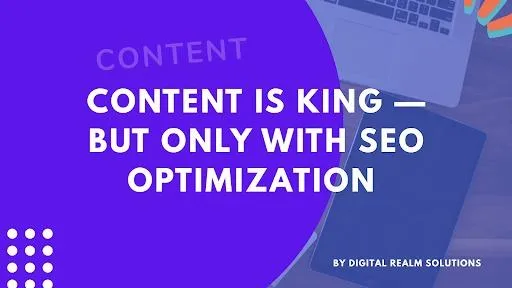
Content is King — But Only with SEO Optimization
Content is King — But Only with SEO Optimization
By Digital Realm Solutions
You’ve likely heard the phrase “Content is King” before. While that’s true, in 2025, it’s no longer the only truth. High-quality content alone isn’t enough to get your website ranked or your audience engaged. What you need is SEO-optimized content — content that not only provides value but is also discoverable, searchable, and aligned with how your audience interacts online.
At Digital Realm Solutions, we help brands produce content that ranks, converts, and drives long-term growth — not just content for the sake of content.
This article will break down:
Why content without SEO doesn’t perform
The core elements of SEO-optimized content
How to create content that ranks and resonates
Tools and best practices for ongoing success
We’ll also target long-tail keywords like how to optimize content for SEO, SEO content writing tips for 2025, and importance of SEO in content marketing.
Why Content Alone Is No Longer Enough
Great content educates, informs, and inspires. But if no one finds it, it can’t do any of that. That's where SEO optimization becomes essential.
Here’s why relying on content without SEO is a mistake:
1. Search Engines Need Signals
Google, Bing, and other search engines use specific signals to determine what your content is about and whether it’s worth ranking. Without proper structure, keywords, and metadata, your content won’t get indexed properly — even if it’s brilliant.
2. Competition Is Increasing
Thousands of blogs are published every minute. The content battlefield is crowded, and SEO gives you the edge to compete and stand out.
3. Algorithms Are Smarter
Search engines now prioritize user intent, content structure, and readability. Simply stuffing keywords won’t work. You need to create optimized content that provides real value to your audience.
What is SEO-Optimized Content?
SEO-optimized content is any form of content — blogs, service pages, product descriptions, guides — created with both users and search engines in mind.
Here are the core components:
Keyword integration (without stuffing)
Search intent alignment
Proper structure with headings and formatting
Internal and external linking
Image optimization
Mobile readability and speed
Meta titles and descriptions
Schema markup where applicable
The Foundation: Keyword Research
Every piece of SEO-optimized content starts with effective keyword research.
How to do it:
Use tools like Ahrefs, SEMrush, or Ubersuggest
Focus on long-tail keywords (more specific, lower competition)
Study search intent (is the user looking to buy, learn, compare, etc.?)
For example:
Instead of targeting "marketing", use “digital marketing strategies for small businesses”
Instead of “SEO tips”, use “SEO content writing tips for 2025”
This approach helps you reach people who are more likely to convert.
Structure is Everything
Google loves structured content because it’s easier to crawl and understand.
Best practices:
Use clear headings (H1, H2, H3) to organize content
Keep paragraphs short and easy to read
Use bullet points and numbered lists for clarity
Add images with alt text to break up text
The Role of Search Intent
Search intent is why someone types a query into Google. Are they:
Looking to buy?
Trying to learn?
Searching for a how-to guide?
Comparing solutions?
You must match your content to the user's intent. A blog should educate or guide, while a product page should convert.
Ignoring intent is one of the most common SEO content mistakes.
Internal Linking and Content Clustering
When you create a lot of content, linking between articles helps:
Improve time on site
Pass authority between pages
Make navigation easier for users
Help search engines understand your topic hierarchy
We recommend using a content cluster model, where you create:
One pillar page (e.g., “Complete Guide to SEO”)
Several supporting blogs (e.g., “How to Do Keyword Research”, “SEO for Local Businesses”)
Internal links connecting them
Meta Tags Still Matter
Your title tag and meta description are what people see in search results. They also help search engines understand your page.
Best practices:
Include your main keyword in the title
Keep title tags under 60 characters
Keep meta descriptions under 160 characters
Write for clicks, not just keywords
Visual Elements Improve Engagement
Adding visuals like:
Infographics
Optimized images
Video embeds
Charts or screenshots
...improves engagement metrics, which in turn boosts SEO rankings. Just make sure images are compressed and include alt text for accessibility and SEO.
Tools to Help You Optimize Your Content
You don’t need to guess your way through SEO. Use tools to guide you:
Tool
Purpose
Surfer SEO
Content structure and keyword density
Grammarly
Grammar and readability
Yoast SEO / Rank Math
On-page SEO for WordPress
Google Search Console
Performance and indexing insights
SEMrush
Keyword tracking and competitive analysis
The Intersection of SEO and User Experience (UX)
Great SEO content is also great for users. Google's algorithms reward content that keeps visitors on-site, answers their questions, and loads quickly.
Focus on:
Mobile responsiveness
Readable fonts and spacing
Fast loading times
Clear call-to-actions (CTAs)
Easy navigation
Case Study: Content Without SEO vs. Content With SEO
Before Optimization:
A client had a well-written blog that was not ranking at all. It had no headings, no keyword targeting, no internal links, and no metadata.
After Optimization by Digital Realm Solutions:
We added long-tail keywords based on search intent
Reformatted the blog with clear headings
Linked it to relevant service pages
Wrote a compelling meta description
Compressed and tagged images
Final Thoughts
Yes — content is still king. But in 2025 and beyond, only SEO-optimized content will rule the digital landscape.
If you’re creating content without strategy, structure, or optimization, you’re missing out on traffic, leads, and visibility.
At Digital Realm Solutions, we help brands create content that ranks, resonates, and returns results. From SEO blogs and landing pages to full content marketing strategies, our team ensures your voice is heard — by the people and the search engines that matter.
Ready to turn your content into your best marketing asset?